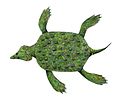| Yuzhoupliosaurus Temporal range: | |
|---|---|
| Scientific classification | |
| Domain: | Eukaryota |
| Kingdom: | Animalia |
| Phylum: | Chordata |
| Class: | Reptilia |
| Superorder: | † Sauropterygia |
| Order: | † Plesiosauria |
| Family: | † Rhomaleosauridae |
| Genus: | † Yuzhoupliosaurus Zhang, 1985 |
| Type species | |
| †Yuzhoupliosaurus chengjiangensis Zhang, 1985 | |
Yuzhoupliosaurus is an extinct genus of plesiosaur from the Middle Jurassic of China. The genus is known only from a lower jaw, eighteen vertebrae, fragments of a pectoral girdle and parts of the right hindlimb. It is believed this genus lived in fresh water.






